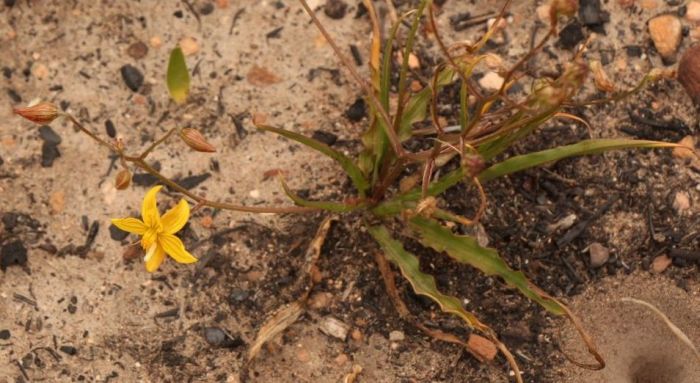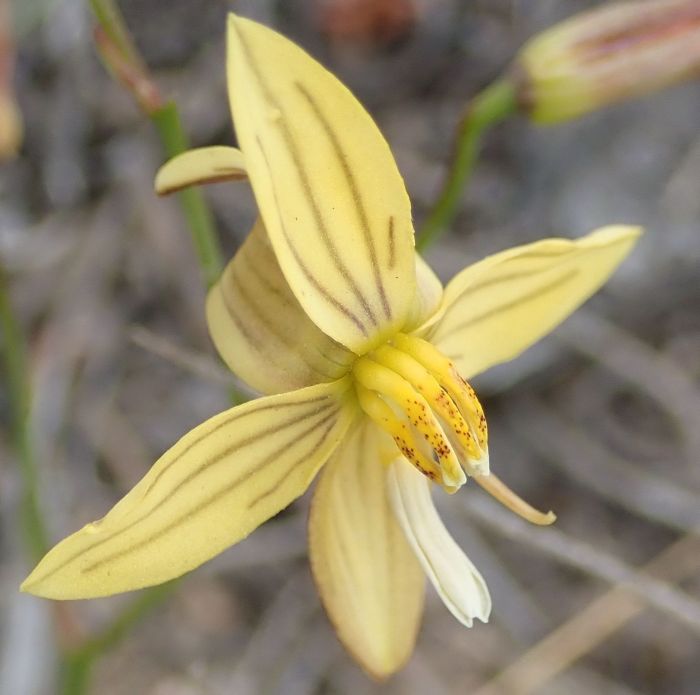Cyanella lutea subsp. lutea
Cyanella lutea L.f. subsp. lutea
Family: Tecophilaeaceae
Common names: five fingers, yellow lady’s hand (Eng.); geelraaptol (Afr.)
Introduction
Cyanella lutea subsp. lutea is a rewarding, long-lived cormous perennial that blooms reliably every year.

Description
Description
This is a deciduous, winter-growing bulbous plant, up to 25 mm tall, with a rootstock that is a corm, a rounded underground storage organ that allows it to survive adverse conditions in summer, in the winter rainfall areas. The tufted, basal, lanceolate, ribbed, hairless leaves, have wavy edges.

The fragrant, bright yellow, orchid-like flowers face outward and are borne in branched racemes, on spreading pedicels in spring, from September to October. The flowers are enantiomorphic, they show a kind of floral asymmetry where the flowers have 2, mirror-image morphs.

The fruit is a capsule containing many small, black seeds.
Conservation Status
Status
This species conservation status is assessed as Least Concern (LC) according to SANBI`s Red List of South African plants. The population of the species is widely spread and not endangered.

Distribution and habitat
Distribution description
Cyanella lutea subsp. lutea is endemic to winter rainfall regions of South Africa, extending from the Namaqualand Klipkoppe, the Bokkeveld Escarpment and southern Roggeveld, to the Cape Flats and Bredasdorp in the south and eastwards through the Little Karoo, to Uitenhage. This subspecies is restricted to renosterveld shrubland on fine-grained clay soils, rarely on stony limestone flats, at altitudes of 50–1 150 m. In Namaqualand it is also found in loamy soils.
At the Karoo Desert National Botanical Garden in Worcester, this plant grows in soils derived from Malmesbury Shale, a fine grained clay soil, in Breede Shale Renosterveld, experiencing minimum temperatures of -1ºC, maximum temperatures of 40ºC and an average rainfall of 250 mm rain per year.

Derivation of name and historical aspects
History
The genus Cyanella is derived from the Greek kyanos, meaning ‘blue’ and –ella, the diminutive referring to the small blue flowers of Cyanella hyacinthoides, the first species to be described. Other species have white, pink, purple and bright yellow flowers. The specific epithet lutea comes from the latin luteus, meaning ‘golden-yellow’, referring to the flowers. The Afrikaans common name geelraaptol is derived from the turnip (raap) shape or taste of the corm or from the resemblance of the corm to a top (tol), because of its long neck.
There are 8 species of this genus, 2 species occur in the Klein Karoo. Other noteworthy members are Cyanella alba with their solitary, white, magnolia-scented flowers, with a hint of light yellow; C. cygnea, with its spectacular flowers, with anthers that look like swans; C. hyacinthoides, with their attractive violet-scented, pale lilac or mauve flowers, and C. ramosissima, with a sub-dense inflorescence of pink to bluish mauve flowers.
Ecology
Ecology
The golden-yellow flowers of Cyanella lutea subsp. lutea are sweetly-scented and buzz pollinated. When a certain frequency is discharged by their specialist pollinator, large solitary bees belonging to the family Apidae: Anthophoridae, this causes the anther to reverberate and the pollen is expelled. The deep-seated, fibrous, tunicate, corms are adapted to aridity and possibly to deter the porcupines and francolins from digging them up.

Uses
Use
In the early days at the Cape (and it is still popular today in some rural districts), an ointment was made by frying the leaves and flowers of Lobostemon fruticosus (agt-dae-geneesbossie) in butter with leaves of Melianthus major (kruidjie-roer-my-nie) and M. comosus, and the corms of Cyanella lutea, and used to treat sores on the legs, especially in women, and for the external lesions of syphilis.
South African people also once used the corm to make a paste for the treatment of boils, carbuncles and abscesses and also for the treatment of leg wounds. This plant is used by the Xhosa people to treat infertility. The patient uses it as a bedding to sleep on and afterwards, it is used in a ritual that takes place at the river.
The corms are edible and are either eaten raw or roasted or boiled in milk and are nutritious with a relatively low moisture content and a high protein content.
These plants are ideal for deep pots and rock gardens.

Growing Cyanella lutea subsp. lutea
Grow
Cyanella lutea subsp. lutea prefers full sun and a coarse, well-drained soil medium. Keep the plants dry in summer.
Sow seed in autumn (March). It takes about 3 to 4 weeks for fresh seeds to germinate and seedlings usually flower in the third year. They should be kept barely moist by using a mist sprayer and allowed to become dry when the foliage dies. The seedlings in the second season can be planted in individual containers and should be large enough to plant out at the end of the second season of growth.
In summer, after the foliage has died down, the corms can be lifted and the cormels/cormlets separated to increase the stock. The cormels/cormlets can then be planted in a sharply drained medium such as equal parts of coarse river sand, industrial (silica) sand and fine compost, with regular heavy drenching during the winter-growing and spring-flowering periods.
The corms can be planted in front of a rock garden because they are not tall and can be left undisturbed for up to 5 years.
Plant Cyanella lutea subsp. lutea together with companion plants such as Aptosimum indivisum (karoo violet) with their attractive violet-like flowers with purple marks around the white throat, Crassula arborescens (beestebal) with its contrasting blue-grey foliage, Crassula rupestris (sosatiebossie) with their striking leaf arrangement, Euphorbia mauritanica (geelmelkbos) with their pencil-shaped stems, Gonialoe variegata (kanniedood) with their mottled leaves, Lessertia frutescens (kankerbos) with their dainty greyish green leaflets and attractive orange-red flowers, Othonna arbuscula (knolhaarpuis), which looks like a bonsai when deciduous and Pelargonium articulatum (kransmalva) with their large, showy cream-coloured or white flowers.
The developing flower buds are sometimes attacked by aphids; use a soapy solution to control this, but the corms and leaves are seldom subject to pests and diseases.
References
- Bryan, J.E. 1989. Bulbs, vol. 1. Timber Press, Oregon.
- Duncan, G. 2010. Grow bulbs. A guide to the cultivation of bulbs of South Africa and neighboring countries. Kirstenbosch Gardening Series. South African National Biodiversity Institute, Cape Town.
- Germishuizen, S., Meyer, N.L., Steenkamp, Y. & Keith, M. (eds) 2006. A checklist of South African plants. Southern African Botanical Diversity Network Report No.41. SABONET, Pretoria.
- Le Roux, A. 2015. Wild flowers of Namaqualand. Struik Nature. Cape Town.
- Manning, J.C. & Goldblatt P. 2012. A revision of Tecophilaeaceae subfam. Tecophilaeoideae in Africa. Bothalia 42(1): 21–41.
- Manning, J., Goldblatt, P. & Snijman, D. 2002. The color encyclopedia of Cape bulbs. Timber Press, Cambridge.
- Roberts, M. 1990. Indigenous healing plants. Southern Book Publishers, Halfway House, Johannesburg.
- Smith, C.A. 1966. Common names of South African plants. Memoirs of the Botanical Survey of South Africa No. 35. Government Printer, Pretoria.
- Thistleton-Dyer, W.T. 1896. Flora capensis: being a systematic description of the plants of the Cape Colony, Caffraria and Port Natal (and neighbouring territories) 6: 6, 7. Reeve & Co. London.
- Van Wyk, B.-E. & Gericke, N. 2000. People's plants, a guide to useful plants of southern Africa. Briza Publications, Pretoria.
- Vlok, J. & Schutte-Vlok, A-L. 2015. Plants of the Klein Karoo. Umdaus Press, Hatfield.
Credits
Shireen Harris
Karoo Desert National Botanical Garden
July 2020
Acknowledgements: Photos by Nicola van Berkel, Sandra Falanga, Yvette van Wijk and Alice Notten.
Plant Attributes:
Plant Type: Bulb
SA Distribution: Eastern Cape, Northern Cape, Western Cape
Soil type: Sandy, Clay, Loam
Flowering season: Spring
PH: Acid, Neutral
Flower colour: Yellow
Aspect: Full Sun
Gardening skill: Easy
Special Features:
Horticultural zones









Rate this article
Article well written and informative
Rate this plant
Is this an interesting plant?
Login to add your Comment
Back to topNot registered yet? Click here to register.